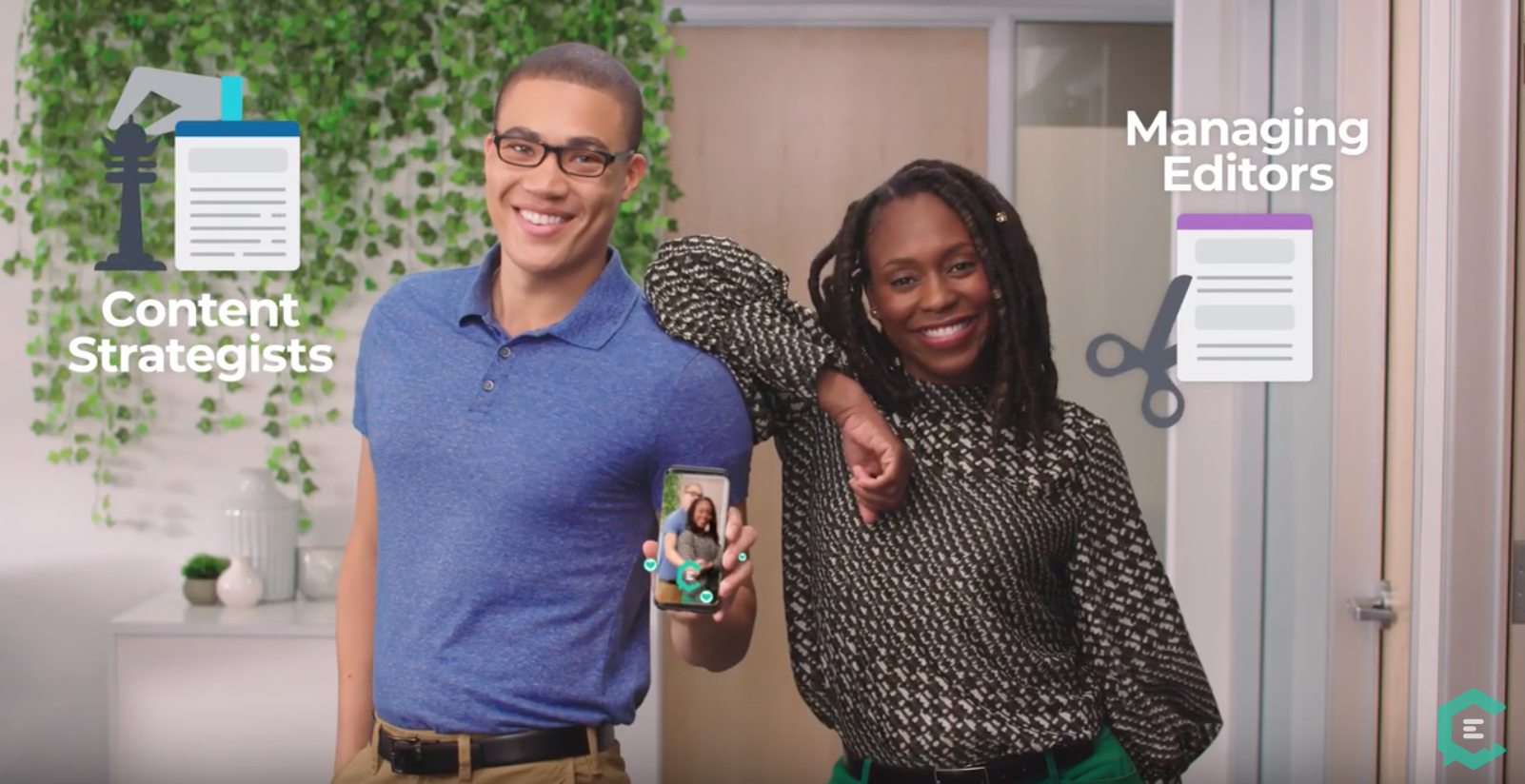“So… what does your company do?”
It’s a question that can either thrill or haunt a marketer. The savvy give a quick elevator pitch nailing the right words and sell amid a flurry of well-connected sentences — while others clumsily wade through a sea of ‘ummms’ and ‘hmmms’ squandering the opportunity.
There’s an increasingly popular Plan B option that allows both to answer quickly and confidently. It goes something like, “Hey, have you seen our explainer video yet?” Way easier, and truth be told: Plan B is fast becoming most companies’ Plan A.

What is an explainer video?
In essence, an explainer video is a short 1- to 3-minute video that breaks down who a company is, the product they sell (or service they provide) and how both of these can help their customers. The best increase traffic, conversions and awareness, serving as a fun and engaging device used across a company’s site and marketing channels.
But perhaps it’s the style in which this gets done that separates an ‘explainer’ from a product video as the best delight their audiences in an entertaining fashion using anything from animation to live-action — to keep audience attention from first moment to end. A cross-breed between a commercial and product video designed to dazzle the digital generation.
The good news is that we all like entertainment. If there’s one thing good about the glut of digital videos we consume daily, it’s that the demand for quality has gone up while our collective tolerance for being sold to has gone down. If you’re going to win attention at the very least — and brand advocacy at the very most — you need your explainer video to score on multiple levels.
Witness three of the all-time greats in the form of Dollar Shave Club, Dr. Squatch, and Chatbooks. Not only did they enlighten their audiences about products new to market, but they were groundbreakingly innovative and creative AF.
In addition, each video positively impacted business and awareness, delivering viral performances at 26+ million, 98+ million, and 5+ million views, respectively — generating impressive earned-media numbers along the way.
But humor and live-action aren’t the only way to go.
There are many other approaches — more friendly to the bottom line — that are more common these days, given practicality. These range from the classic whiteboard approach to a classic 2D animation (such as what HeadSpace employs) to 3D animation, which can work well for products with more dynamic visuals.
If you have any questions about what kind of video you should be trying to make for your company, here’s a quick breakdown of different types. It’s important to understand what it is you actually need to be since unfocused videos may not deliver optimal ROI.
Recently, I helped produce an explainer for ClearVoice that used touches of humor and motion graphics to give a sense of the service. Having just gone through the process, we thought it would be good to share a few tips from our pursuit to help you produce your own.
5 Steps for creating an engaging explainer video
So, here are five key areas you’ll want to be cognizant of if you’re going to create such a video. Then, the next time someone asks what your company does, you won’t have to do language limbo in front of them…
You can just send them a link.
[Please note: The following advice is primarily designed for creating a live-action explainer, a la the ClearVoice approach. For animated videos, the process will, of course, vary in terms of execution.]
1. Create a strategy.
The first step is always to decide what style of explainer video will work best for your company, given budget considerations, the brand, and the ultimate goals for the project. One key is to know your audience and what visual style they might be most receptive to.
Here are a few key questions to ask yourself to kick off the process:
- Will explaining what your product or service does require a live demonstration, or can graphics do the heavy lifting?
- Along these lines, how much can be said versus needing to be shown graphically through motion graphics, animation, or screenshots?
- What’s your budget? Do you only have a few grand to spend? Or can you go bigger?
That last question is an important one. If you have a small $1K-$2K budget, you’ll likely want to consider a classic whiteboard or simple animated approach. If you’re in the $2K-5K range, a 2D animation is probably going to tell your story best. If you’re looking to make a live-action splash with actors and other real-world dynamics, you’re looking at anywhere from $5K to $50K, depending on creative variables such as time, talent, and technology.
Another strategic consideration is to focus on the product you’re offering and what format is best suited. I think this “Generic Brand Video” by Dissolve did an incredible job at capturing their essence because it was made entirely using stock footage from their site, using a brilliant script and genius Sam Elliott-esque V.O. by professional voice actor, Dallas McClain.
For the ClearVoice explainer, we aimed to create an upbeat video that informed using humor. We wanted to introduce what ClearVoice offered (freelance talent, an all-in-one marketing solution, etc.) in a way that answered why a marketer might use the service.
Once we made those decisions, it brought us to the next step…
2. Work on scripting.
Once you’ve nailed down your strategy and style for the video, you’ll need to create a script that takes several things into account to keep this project focused, on track and on budget.
- Consideration #1 — Being realistic: Given what you have to spend, how many physical setups, camera moves, and scene changes are realistic to get this done with the budget you have? Can you shoot it in a day, or will you need two?
- Consideration #2 — Product benefits: How many product features/benefits should realistically be featured in the video so you don’t bore your audience to tears? What’s essential, and what can be left to the website for heavier lifting?
- Consideration #3 — Talent: How many actors need to star in this thing to tell your story? Actors cost $$$, so make sure everyone is essential to the cause. Avoid unnecessary characters or gratuitous cameos!
The script stage is also the time to decide where you can lean on motion graphics to tell the story — without relying on actors to say too much. Every word that goes into that script counts. You can’t pay too much attention to the process while it’s in the script stage. (See how I used bold and italics there?) There’s a cost to every word and every action that goes into this script. From it, you’ll derive everything from your shot list to props to a slew of other production details.
Also, the length of the video, as each page, is generally around a minute of screen time, depending on how much dialogue and action is written into this bible of sorts.
Have any doubt that every word should count? Just wait until those tasked with shooting the script get their hands on it. That’s when every word gets scrutinized, like a forensic scientist examining a particle of blood. Which brings me to my third point…
3. Find the right production company.
Once you have a finished script, it’s imperative to find the right production company (if not in-house) to execute your script within the confines of the budget. Someone who shares a vision for what the project should be and has experience accomplishing such a task. To that end, we found Butcher Bird Studios for the ClearVoice video, a full-service production company with experience producing live-action videos and commercials in the digital space.
Once you have the right production company as co-captain, you now have a partner to ask all the questions you may (or may not) have thought of. Ideally, this experience and production know-how will propel you forward. In this regard, Butcher Bird brought a slew of relationships to the ClearVoice video that benefitted the overall production. Everything from helping to cast the lead actress Dana Deruyck to finding the right location to shoot in, which in this case, was a nearby stage and ad agency where Butcher Bird had shot in the past.
Why do you want a production company with experience? Well, mostly because you don’t want… surprises. The other “S” word. You want the budget presented to be reflective of the final cost of the project so you do not incur overages or a resentful partner who failed to account for things and suddenly finds themselves going out of pocket, making compromises that will ultimately affect the video’s quality, message and overall effectiveness.
That’s one reason you’ll want to do storyboards to map out every scene in advance. Also, to come to a consensus about the best way in which to shoot the video — that is, using a 4K camera or high-definition (HD). Maybe you can even do everything you need on an iPhone.
A good production company or animation house will guide you through the considerations to be made based on the video’s destination, how it gets used, and ultimately stored. For example, 4K files are hefty, so if you’re going that route, you should really know why… and this is one place where an expert production team will earn their stripes during the process.
4. Shoot the video.
This is the day (or days) that must go right, or the quality of your video could suffer enormously. From the call sheet that goes out the night before to understanding what equipment you’ll be shooting with (and the crew needed to do it), the shoot day is the pinnacle of the hard work done thus far. It can be a day filled with laughter or high fives as the script plays out on-screen brilliantly. Or it can be filled with anxiety, shot compromises, and unfortunate pivots due to unforeseen circumstances that can weaken your production.
For the ClearVoice video, we had a prep day the day before the shoot to set each shot up, adjust lighting, and agree on camera movements so we could make decisions in advance so we weren’t scrambling the day of. If you can afford this luxury, I can’t express how important it will be to walk through it all the day before to save time on the shoot day, as it helps everyone (creatives, crew, and clients) envision how things will go before it’s gone time.
This shot in our video specifically required a degree of choreography because it had several moving parts/actors around the host. All were leaving room for motion graphics that didn’t yet exist.
Another tip is to get comfortable with your director and cinematographer well in advance, if possible. They ultimately make or break this shoot with the direction they give to actors and the look/feel of the video.
Developing a strong rapport with these people from prep day through martini shot will set your project up for success… not a production nightmare.
5. Deliver the final explainer in post.
Just because your shoot day is behind you doesn’t mean this video is just going to finish itself. You need to take it across the finish line. So, how do you do that?
Good question.
For the ClearVoice video, that’s when the real work began in terms of reviewing different cuts of the video (aka candidates), different styles for motion graphics, and even different takes we got in the can. Sometimes, the best performance is obvious, but other times, the differences are subtle, so they’re worth reviewing to capture the right one.
To that end, as the client, it’s worth marking your favorite takes on the shoot day as you watch the monitor in video village. This will keep you ahead of the game before heading into post-production.
Don’t have a favorite take, or maybe there’s a slight hiccup with the one you like in the form of a pause, ambient noise… or even an actual hiccup? That’s where a little movie magic and editing tricks can save the day — and a shot.
Explainer videos have the difficult task of teaching someone what a product is and does in a creative way, without lengthy explanations or excessive reading. To that end, it’s also really important to keep an eye on the flow of the video to keep things moving.
That’s where music is extremely important to keep it all stimulating. I must’ve listened to 300-400 tracks to find the three we used in our video. The right music makes a world of difference. The wrong music can pull the viewer out of the video and destroy all the other good faith you’ve built up. If you have any doubts about this, here’s a quick video that breaks down the concept for film. Tone is everything.
The post process can take days or weeks to get it right, depending on how many rounds of review you have built into your estimate — and how finicky you are about the ultimate video. Luckily, both Butcher Bird and ClearVoice hit their review milestones to keep our project on track and without unnecessary delays. That’s the way it should be, ultimately.
Excessive revisions beyond scope and missed deadlines can just add pain to a process that thrives without pain while de-motivating people who are pouring long hours into a project.
One Final Thing to Consider When You’re Completing Post
If you shoot a live-action variation as we did, you should consider ways to use other footage you’ve shot to feed your social channels. Just because it doesn’t make the final cut doesn’t mean it’s not useful. Being creative with the footage shot to create GIFs, BTS footage (behind the scenes), or even a blooper reel to feed your content channels could maximize what you’ve captured and make your brand feel more human and accessible.
This approach may not be for everyone — but for companies who do employ it correctly, it can offer all sorts of unforeseen/added value.
Speaking of, if you’ve paid attention to the above, chances are you’re ready to endeavor to create your own explainer video to explain what you do to those who want to know.
If that’s the case, make it good!









